The Québec maritime Blog
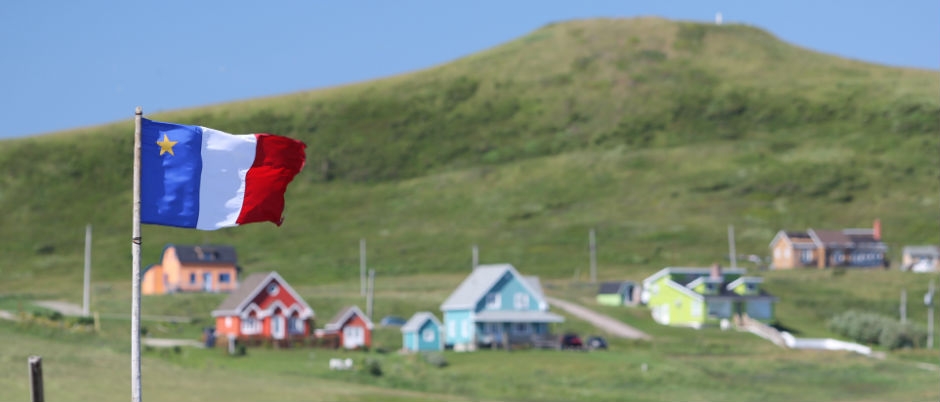
- L'île imagin'air/Tourisme Îles de la Madeleine
Acadian Heritage in Eastern Québec
There are many Acadians in the province of Québec and their presence is particularly pronounced in Eastern Québec. But let’s back up and start with a bit of history: Who are the Acadians and what is Acadia?
In 1604, French settlers established a colony on Sainte-Croix Island, located at today’s border between New Brunswick and Maine, before moving to Port-Royal, on the mainland, the following year. This was the starting point of Acadia. The colony expanded little by little with the arrival of settlers mostly of French origin.
In 1713, the Treaty of Utrecht ended the rule of France in Acadia, which became a British colony. However, the vast majority of Acadians, who spoke French and were Catholics, refused to take the oath of allegiance to the British Crown. The new English leaders were afraid that Acadians would side with France in the event of a conflict. As a result, the deportation of the Acadian population began in 1755: they were sent to the American colonies, France and even England.
Gaspésie
Well before the beginning of the deportation, as early as the second half of the 17th century, Acadians settled in the Chaleur Bay area and elsewhere in Gaspésie, from the mouth of the Restigouche River to Cap-des-Rosiers, on the north side of Forillon. Some even consider the region as part of the original Acadia.
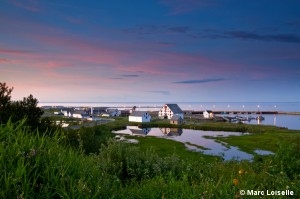
Site historique national de Paspébiac
More settlers arrived in the area following the deportation, and some 1000 Acadians headed to Chaleur Bay. A dozen families founded the parishes of Bonaventure in 1760 and Carleton in 1766. In 1774, Charles Robin, a native of Jersey Island who came to Gaspésie in 1766 to start a fishery business, recruited Acadians among the deportees to France. About a hundred of them came on two ships and settled in the villages of Pabos, Paspébiac, Port-Daniel, Maria, Gaspé and New Richmond.
Today, about 65% of the population of Gaspésie and over 80% of the people living in the Bonaventure area are of Acadian origin.
Îles de la Madeleine
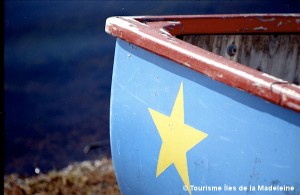
Acadian boat in the Îles de la Madeleine
In the Îles de la Madeleine archipelago, twenty-two Acadians from Prince Edward Island, hired in 1765 by Colonel Richard Gridley, who had just became lord of the archipelago, were the first to settle in the area to hunt seals and fish for lobster. Some 300 more Acadians from Saint-Pierre and Miquelon eventually joined them in 1793, fleeing from antireligious decrees on the French islands.
Due to limited space and economic hardships on the archipelago, many Acadians emigrated from the Îles de la Madeleine in successive waves, especially to Côte-Nord and Gaspésie. Nevertheless, the Acadian spirit is still very strong in the Islands and can be found in the traditions, speech and music of the Madelinots.
Côte-Nord
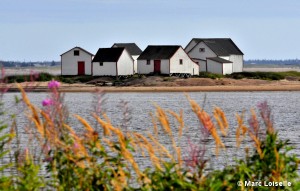
Les Galets heritage site in Natashquan
In Côte-Nord, the settlement of Acadian families goes back to the 1850s. Over a 40-year period, more than a hundred Acadian families from the Îles de la Madeleine settled in Kegaska, Blanc-Sablon, Natashquan, Havre-Saint-Pierre and in the vast Seigneurie de Mingan.
To commemorate their origins, the people of Havre-Saint-Pierre officially proclaimed themselves to be Cayens (a common variation of the word Acadien, or Acadian). When you walk around the village, you will notice that the Acadian flag is proudly displayed in several places.
These families played a crucial role in the region’s history. An Acadian, Dominique Chiasson, founded the city of Sept-Îles in 1872, while the city of Baie-Comeau owes its name to another Acadian: Napoléon-Alexandre Comeau, known as the Roi de la Côte-Nord (the King of the North Shore).
Bas-Saint-Laurent
The relationships between Bas-Saint-Laurent and Acadia started in the early 18th century, before the deportation, with alliances between families from Côte-du-Sud (the western part of Bas-Saint-Laurent) and Acadian families.
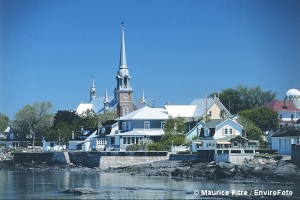
Village of Kamouraska
These relationships intensified in 1755, when a large number of Acadians fled north along the Saint-Jean River and Chemin du Portage in the Témiscouata area, to settle in the Kamouraska, Cacouna, Trois-Pistoles, Rivière-Ouelle and Rimouski areas. Aboiteaux, a type of dyke built to prevent tidewaters from damaging farmland, are a distinctive feature of the Kamouraska scenery and had a major impact on the evolution of the region’s agriculture.
The contribution of Acadians who came to this area can’t be denied.
The Acadian experience in Eastern Québec

Acadian museum in Bonaventure
The best place to get a full sense of the Acadian history of Eastern Québec is the Musée Acadien du Québec in Bonaventure, in Gaspésie. This public space offers numerous cultural and educational activities to help you learn about Acadian heritage. Two permanent exhibits, A Québec Acadia and Acadian Secrets: In the Wings of Grand Pré Street, tell the fascinating and touching story of Acadians in Québec. Movies and shows are also presented during the summer. After your visit, stop in the museum’s gift shops where you will find a wide range of local products, arts and crafts.
Would you like to learn more about the Acadian presence on the Lower North Shore, in Côte-Nord? Relais Nordik offers a maritime service in the region from mid-April to mid-January, transporting people and goods aboard the Bella Desgagnés on a weekly basis to the isolated villages of the Lower North Shore. You can board the vessel in Rimouski, Sept-Îles, Havre-Saint-Pierre, Natashquan or Blanc-Sablon. The ship stops in six villages along the Lower North Shore (Kegaska, La Romaine, Harrington Harbour, Tête-à-la-Baleine, La Tabatière and Saint-Augustin) and also offers service to Port-Menier on Anticosti Island.
Are you curious about Acadian culture and history? Do you have Acadian ancestors? Take advantage of your visit to the maritime regions of Québec to go on a pilgrimage and immerse yourself in the colourful and captivating traditions of modern Acadia!
Sources
http://www.museeacadien.com/
http://acadiensduquebec.org/ (French only)
http://www.rootsweb.ancestry.com/~nsmhs/roger/odyssey/Quebec/refugies.html (French only)
https://www.peninsuleacadienne.ca/en/

(1) comment
Deborah Byrne
Just saying hello because of my beautiful summer holidays in gaspe My grandmother was HELENE LEBLANC from nouvelle My cousin is Hugette Leblanc living in Maria Teaching English in a school there My family goes back to daniel Leblanc from the 1600,s, directly through the father line of my grandmother Funny how I feel the history of my ancestors when I visit there , standing by the river , listening to the wind through the forest My mom grew up in Dalhousie Her dad was Robert Le tourneau A very poetic man who loved nature Just wish to say hello